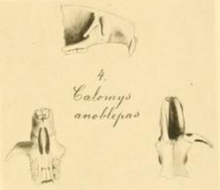| Juliomys anoblepas | |
|---|---|

| |
| Front half of the skull of Juliomys anoblepas, seen from the right, above, and below.[1] | |
| Scientific classification | |
| Domain: | Eukaryota |
| Kingdom: | Animalia |
| Phylum: | Chordata |
| Class: | Mammalia |
| Order: | Rodentia |
| Family: | Cricetidae |
| Subfamily: | Sigmodontinae |
| Genus: | Juliomys |
| Species: | †J. anoblepas
|
| Binomial name | |
| †Juliomys anoblepas (Winge, 1888)
| |
| Synonyms | |
Juliomys anoblepas is a rodent in the genus Juliomys of the subfamily Sigmodontinae known from a single broken skull. The specimen was collected by Peter Wilhelm Lund in the caves of Lagoa Santa, Minas Gerais, Brazil, in the first half of the 19th century and described by Herluf Winge in 1888 as Calomys anoblepas. The species remained unstudied and its affinities unclear until 2011, when it was recognized as a member of the genus Juliomys, which includes three other species from southern Brazil and nearby Argentina and Paraguay. J. anoblepas is probably a separate extinct species of the genus, which is no longer found at Lagoa Santa.
Juliomys anoblepas is similar to the other members of its genus in the configuration of its zygomatic plate (a bony plate on the side of the skull). It hardly extends forward in front of the connection between the plate and the main body of the skull, and that connection is relatively low on the skull. Furthermore, the incisive foramina, openings in the front part of the palate, extend to a point between the first molars, and the palate is short, with its back margin between the third molars. The living species of Juliomys differ from J. anoblepas in various characters, including shorter incisive foramina in two species and the shape of the zygomatic arch (cheekbone) in J. anoblepas. The upper molar row is 4.13 mm long, which makes J. anoblepas the largest known species of Juliomys.